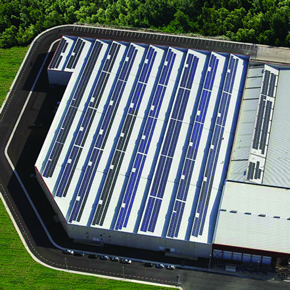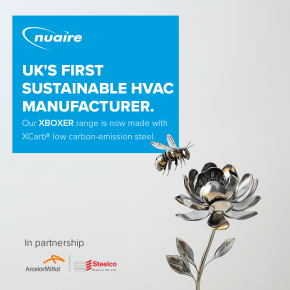
Calculating the performance of solar PV with Carlo Gavazzi
Kevin Sheldrake, business development manager at Carlo Gavazzi, advises that both correct installation and metering should be considered when calculating solar PV performance. PSB Magazine finds out more…
The solar photovoltaics (PVs) market is fast-growing. Financial backers, engineers and building owners are more likely than ever to view solar PV as not only a good investment, but a way of protecting their energy costs as they continue to rise, by reducing their energy bill as well as their CO2 emissions.
The UK Government continues to support this vital technology, to assist the UK in lowering its carbon emissions. Therefore, it is crucial to continue its focus on removing barriers to PV installation. For example, the fact that the equipment might have to be left behind after an office move was regarded as one hurdle to further take-up of commercial PV installations.
In April 2015, the Department of Energy & Climate Change (DECC) announced that from summer 2019, owners of medium and large building-mounted PV systems will be able to take their installations with them if they choose to relocate.
The DECC estimates that the UK has around 250,000 hectares of south-facing, commercial rooftops, so it is highly likely that the use of PV is going to continue growing in the UK. Industrial and commercial solar installations have seen a major boost in applications in the past year and are in line to catch up with the domestic PV market.
Solar PV market developments
Carlo Gavazzi’s continuous involvement in this market certainly bears out these growth indicators. Between 2009 and 2014, the company has been involved with over 2,000mW of installed solar power around the world, which amounts to around 1,800 running installations.
Building owners have grasped the opportunities offered to save energy while making money, by selling power back to the grid as well as providing a visible statement which demonstrates a clear commitment to environmental sustainability.
Although the use of PVs on a large scale used to be concentrated in the sunnier areas of Europe such as Spain and Italy, PV technology has now moved on. It is possible, even here in the UK to produce significant amounts of energy using the latest PV equipment.
PV metering and monitoring
The correct specification and installation of technology, such as PVs, is important. However, metering and monitoring of this equipment is equally vital to good, long-term performance and ensures optimum benefits are achieved. Renewable technologies are an investment and a good metering strategy is vital to both enhance and measure the return on that investment.
If a solar installation (whether roof-top mounted or a large, ground-based project) is not correctly monitored, a missed fault can result in significant financial losses. It is possible to lose 20% efficiency and, without a good metering strategy, that might not be spotted until a drop-off in power output is detected.
For solar PVs therefore, metering and monitoring will provide clear and concise indication of system performance which will ensure revenue optimization.
The collection and use of data is also central to the function of good controls, to ensure that a PV system is operating as efficiently as possible. The management and control system for photovoltaic plants has to operate at a number of levels. Firstly, it must measure aspects of the system such as AC and DC monitoring; it must also offer environmental sensing as well as alarm logging.
Good controls will ensure that the engineers or designated recipients are sent email or SMS messages making them aware of any alarms, such as the PV has stopped working or has been compromised in any way.
Performance can be lost if the inverter fails or if they are not correctly connected; dust or dirt can accumulate on the surface reducing the output or even panels being stolen. The latest controls can also help to identify the exact location of a fault, which reduces servicing time and missed yields.
Secondly, the controls should focus on gathering and communicating useful information to the operators. This includes local and remote databases of historical data as well as analysis functions. The latest controls will also be able to deliver the information via the web to a location that suits the users. This could be an energy management company or an in-house facilities team, or both.
Solar PV technology and its benefits
Solar PV technology is flexible – it can be used across a range of sizes of installation, therefore the controls applied should be equally as flexible. Carlo Gavazzi is involved with monitoring and metering solar projects ranging from 20mMW, which accounts for around 300,000 monitored strings.
Given the importance of delivering data on installation performance, users should also look for controls that offer TCP/IP communication capability. This means that data can be sent exactly where the client needs it. Also, it is important to look for features such as SMS or email notifications of plant failure – given that downtime for a solar installation means lost revenue and maintenance costs.
As the solar PV market expands, there is no doubt that potential users and investors will be looking closely at the array of technologies.
However, it is equally important to consider good quality metering and monitoring as a key part of the whole system – without these technologies, there is no way of ensuring that the investment is providing good value for money.
Find out more in the APRIL ISSUE of PSB MAGAZINE
Latest news

29th April 2025
West Fraser range delivering key benefits for South-East carpentry company
An experienced carpenter and building site manager who has recently set up his own company is using high performance panel products from the West Fraser range.
Posted in Articles, Building Industry News, Building Products & Structures, Building Systems, Case Studies, Garden, Restoration & Refurbishment, Retrofit & Renovation, Sustainability & Energy Efficiency, Timber Buildings and Timber Products
29th April 2025
CPD Courses Available Online From Ecological Building Systems
Ecological Building Systems, a leading supplier of natural building products for sustainable construction, has revealed its comprehensive CPD programme for the year ahead.
Posted in Articles, Building Industry Events, Building Industry News, Building Products & Structures, Building Services, Continuing Professional Development (CPD's), Information Technology, Innovations & New Products, Insulation, Restoration & Refurbishment, Retrofit & Renovation, Seminars, Sustainability & Energy Efficiency, Training, Walls, Waste Management & Recycling
29th April 2025
WindowBASE launches new prospect databases at FIT Show
Visit WindowBASE at the FIT Show to see first-hand how it helps companies find new customers – the company is launching an easy-to-use, intuitive platform on Stand G16 at the NEC Birmingham from 29th April – 1st May.
Posted in Articles, Building Industry Events, Building Industry News, Building Products & Structures, Building Services, Doors, Exhibitions and Conferences, Glass, Glazing, Information Technology, Innovations & New Products, Posts, Publications, Research & Materials Testing, Restoration & Refurbishment, Retrofit & Renovation, Windows
28th April 2025
Nuaire first UK ventilation manufacturer to use low carbon-emissions recycled & renewably produced steel
Nuaire has announced that its Magnelis® steel based ventilations systems are now being made from XCarb® recycled and renewably produced steel.
Posted in Air Conditioning, Articles, Building Industry News, Building Products & Structures, Building Services, Building Systems, Heating, Ventilation and Air Conditioning - HVAC, Restoration & Refurbishment, Retrofit & Renovation, Steel and Structural Frames, Sustainability & Energy Efficiency, Waste Management & Recycling
 Sign up:
Sign up: